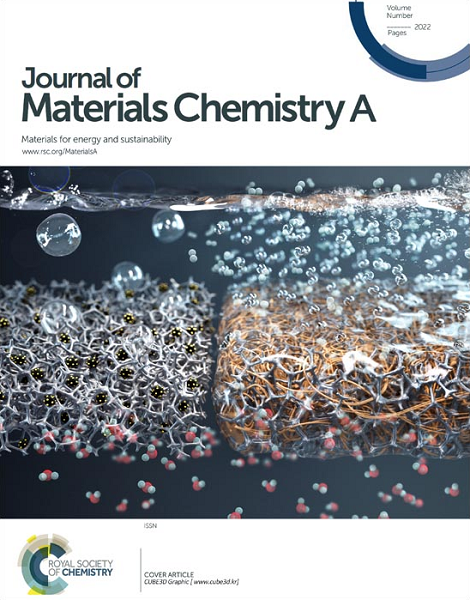Unlocking Zn Storage Performance of Ammonium Vanadate Nanoflowers as High-Capacity Cathodes for Aqueous Zinc-ion Batteries via Potassium Ion and Ethylene Glycol Co-Intercalation Engineering
IF 10.7
2区 材料科学
Q1 CHEMISTRY, PHYSICAL
引用次数: 0
Abstract
Ammonium vanadate (NH4V4O10) is a highly promising cathode for aqueous zinc ion batteries (AZIBs) due to its tunable layered structure and high specific capacity; however, limited active sites, poor kinetics and irreversible structural collapse during cycling suppress its wide application. Herein, the engineering of the co-intercalation of K+ and ethylene glycol molecules is proposed to unlock Zn storage performance of the NH4V4O10. It is found that the co-intercalation of K+ and ethylene glycol enlarges the interlayer spacing to 11.5 Å, induces a high level of oxygen vacancies and enhances the strength of ionic bonding in the NH4V4O10, ensuring large Zn2+ diffusion channels, efficient redox reactivity and strong layered-structure stability. Meanwhile, K+ ions and ethylene glycol also weaken the crystallinity of NH4V4O10 and induce the transformation of microscopic morphology from strips to nanoflowers self-assembled from ultrathin nanosheets, promoting the transfer of electrons and ions and complete penetration of the electrolyte during electrochemical reactions. In addition, the band gap is significantly reduced by 0.2 eV after the co-intercalation of K+ and ethylene glycol, improving the electronic conductivity and decreasing the diffusion barrier of Zn2+. As expected, K+ and ethylene glycol co-intercalated NH4V4O10 exhibit excellent Zn storage properties, delivering an ultrahigh capacity of 614.1 mAh g-1 at 0.5 A g-1, and presenting an outstanding rate performance of 472.9 mAh g-1 and a high retention of 89% after 2000 cycles at 10 A g-1. This work provides a useful reference for unlocking the Zn storage performance of layered V-based cathodes for AZIBs by synergistically modulating interlayer spacing, oxygen defects and microscopic morphology of the materials.通过钾离子和乙二醇共钙化工程释放作为锌离子水电池高容量阴极的纳米钒酸铵的锌储存性能
钒酸铵(NH4V4O10)具有可调的层状结构和高比容量,是一种极有前景的水性锌离子电池(AZIBs)阴极;然而,有限的活性位点、较差的动力学性能和循环过程中不可逆的结构坍塌阻碍了它的广泛应用。本文提出了 K+ 与乙二醇分子共掺杂的工程学方法,以释放 NH4V4O10 的锌存储性能。研究发现,K+和乙二醇的共掺杂将层间距扩大到 11.5 Å,诱导了高水平的氧空位,增强了 NH4V4O10 中离子键的强度,从而确保了较大的 Zn2+ 扩散通道、高效的氧化还原反应性和较强的层状结构稳定性。同时,K+ 离子和乙二醇也会削弱 NH4V4O10 的结晶度,诱导其微观形貌从条状转变为由超薄纳米片自组装而成的纳米花,促进电化学反应过程中电子和离子的转移以及电解质的完全渗透。此外,K+ 和乙二醇共掺杂后,带隙显著减小了 0.2 eV,从而提高了电子传导性并降低了 Zn2+ 的扩散障碍。正如预期的那样,K+和乙二醇共掺杂的 NH4V4O10 表现出优异的锌存储特性,在 0.5 A g-1 的条件下可提供 614.1 mAh g-1 的超高容量,在 10 A g-1 的条件下循环 2000 次后可提供 472.9 mAh g-1 的出色速率性能和 89% 的高保持率。这项工作为通过协同调节材料的层间间距、氧缺陷和微观形态来释放层状 V 基 AZIB 阴极的锌存储性能提供了有益的参考。
本文章由计算机程序翻译,如有差异,请以英文原文为准。
求助全文
约1分钟内获得全文
求助全文
来源期刊

Journal of Materials Chemistry A
CHEMISTRY, PHYSICAL-ENERGY & FUELS
CiteScore
19.50
自引率
5.00%
发文量
1892
审稿时长
1.5 months
期刊介绍:
The Journal of Materials Chemistry A, B & C covers a wide range of high-quality studies in the field of materials chemistry, with each section focusing on specific applications of the materials studied. Journal of Materials Chemistry A emphasizes applications in energy and sustainability, including topics such as artificial photosynthesis, batteries, and fuel cells. Journal of Materials Chemistry B focuses on applications in biology and medicine, while Journal of Materials Chemistry C covers applications in optical, magnetic, and electronic devices. Example topic areas within the scope of Journal of Materials Chemistry A include catalysis, green/sustainable materials, sensors, and water treatment, among others.
 求助内容:
求助内容: 应助结果提醒方式:
应助结果提醒方式:


